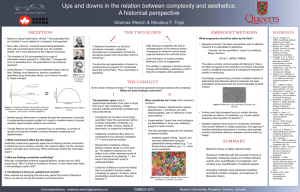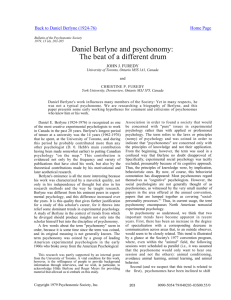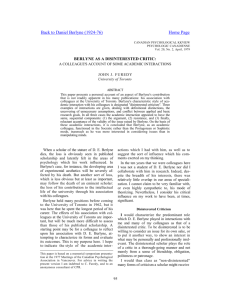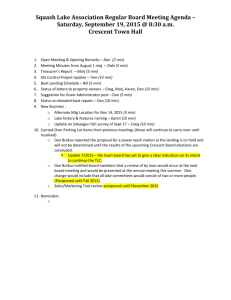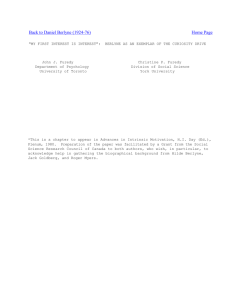Day (1979) in Memorium - University of Toronto
advertisement
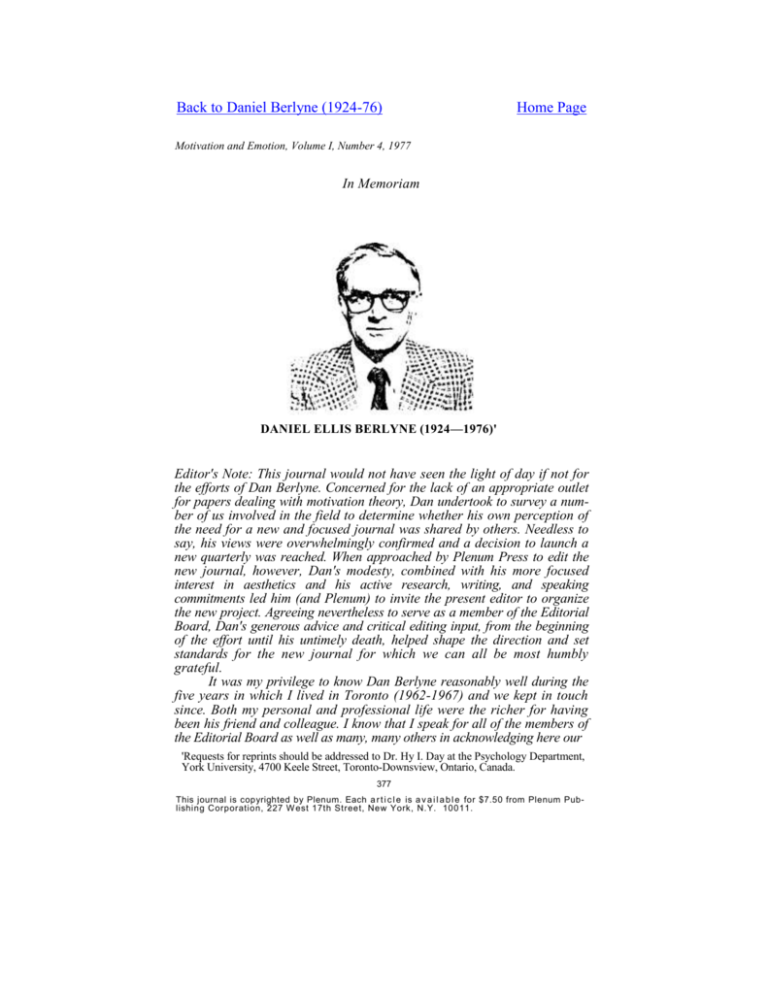
Back to Daniel Berlyne (1924-76) Home Page Motivation and Emotion, Volume I, Number 4, 1977 In Memoriam DANIEL ELLIS BERLYNE (1924—1976)' Editor's Note: This journal would not have seen the light of day if not for the efforts of Dan Berlyne. Concerned for the lack of an appropriate outlet for papers dealing with motivation theory, Dan undertook to survey a number of us involved in the field to determine whether his own perception of the need for a new and focused journal was shared by others. Needless to say, his views were overwhelmingly confirmed and a decision to launch a new quarterly was reached. When approached by Plenum Press to edit the new journal, however, Dan's modesty, combined with his more focused interest in aesthetics and his active research, writing, and speaking commitments led him (and Plenum) to invite the present editor to organize the new project. Agreeing nevertheless to serve as a member of the Editorial Board, Dan's generous advice and critical editing input, from the beginning of the effort until his untimely death, helped shape the direction and set standards for the new journal for which we can all be most humbly grateful. It was my privilege to know Dan Berlyne reasonably well during the five years in which I lived in Toronto (1962-1967) and we kept in touch since. Both my personal and professional life were the richer for having been his friend and colleague. I know that I speak for all of the members of the Editorial Board as well as many, many others in acknowledging here our 'Requests for reprints should be addressed to Dr. Hy I. Day at the Psychology Department, York University, 4700 Keele Street, Toronto-Downsview, Ontario, Canada. 377 This journal is copyrighted by Plenum. Each a r t i c l e is a v a i l a b l e for $7.50 from Plenum Publishing Corporation, 227 W est 17th Street, New York, N.Y. 10011. 378 Day deep indebtedness to Dan Berlyne and in expressing our sorrow at the loss of the person and the intellect, both of which will be sorely missed. We have turned to Hy Day, Dan's student, friend, colleague, and collaborator to review briefly here the record of Dan Berlyne's contributions. M .H.A. Daniel Ellis Berlyne was born in Salford, England in 1924 and died on November 2, 1976, in Toronto, Canada. During his 52 years of life Dan managed to write or coedit seven books and approximately 150 articles and chapters. While most of his publications were in the area of curiosity and fields closely related to it, he also created such diverse offerings as Humor and Its Kin (1972a), Invited Commentary: B.F. Skinner's Beyond Freedom and Dignity (1972b) and Behaviorism? Cognitive Theory? Humanistic Psychology?— To Hull with Them All (1975). His work has been translated into six or seven languages and the impact of his ideas is felt internationally. He lectured in eight languages on five continents and carried on his research in North and South America, Europe, Africa, and Japan. It would be simplistic to summarize Dan Berlyne's contribution to psychology by noting that he introduced the concept of curiosity. Yet a brief comparison of Psychological Abstracts prior to 1960, when his first book Conflict, Arousal and Curiosity appeared, and any recent volume shows the growth of the new concept and Dan's influence in the research in and theoretical contributions to the area. In 1975, 15 years after the publication of his first book and long after he had radically departed from many of its tenets, the Social Science Citation Index lists 78 references to it. Dan Berlyne tended to explore both widely and deeply. If one were to seek the most descriptive adjective for him, it would be "curious." But just as Dan recognized that curiosity is not a unitary concept, so too Dan was not curious in a unitary manner. In fact, one can find a parallel in Dan's character for each of the subdivisions of curiosity—specific and diversive, perceptual and epistemic, broad-band and in-depth. Interestingly, Dan tended to avoid studying the state of curiosity and preferred to look at exploratory responses as the important variable. He, too, was a man of action and was happiest active in his laboratory designing, conducting, and analyzing his research. Early in his professional career Dan recognized that the impact of objects and events can be measured along three dimensions—psychophysical, ecological, and collative. His interest was in the last of these and he defined collation as the examination of similarities and differences, and compatibilities and incompatibilities among elements of an object or event. [Incidentally, Dan was an insatiable creator of words and phrases and collative variability was only the first in a long series of creations that included the title of a chapter called The Vicissitudes of Aplopathematic and Thelemato- In Memoriam 379 scopic Pneurnatology (or The Hydrography of Hedonism.)] Included under the rubric of collative variables were such characteristics as complexity, novelty, change, conflict, and many others, all of which were said to induce uncertainty. Dan claimed to be the first to introduce the concept of curiosity into the literature. In 1949 he published his first paper on 'Interest' as a Psychological Concept. From then until 1960, when his first book stressed the concept of arousal, he considered himself to be a true Hullian drive theorist. Thus, his 1957 paper Attention to Change, Conditioned Inhibition (SIR) and Stimulus Satiation was only one in a series of papers that examined exploratory behavior as a response to a drive state. Berlyne came to Yale in 1952, with an M.A. from Cambridge, intending to study with Clark Hull. But that was not to be because Hull died that year and Dan was assigned to work with Hovland. He found his Ph.D. studies were not too arduous and managed to teach at Brooklyn College and get married while earning his Ph.D. at Yale in 1953. Then followed a period of travel and exploration, ranging across the American continent, a few years at Aberdeen, and one year in Geneva, before settling down at the University of Toronto in 1962. By then he had managed to publish about 27 papers and two books, one of which he wrote with Piaget in French. The book Conflict, Arousal and Curiosity marked for Berlyne a new position and the introduction of a personal theory of curiosity in which response conflict and arousal were central concepts. Even prior to 1960, Berlyne was losing his status as a pure S-R Hullian disciple. In his book The Motivation of Behavior (1961) J. S. Brown reflected this as follows: Although Berlyne has tried to cast his views into a form consistent with Hullian theory and lo extend it into the general area of perception, his usage of the term drive is not coordinate with Hull's. Berlyne’s curiosity drive is . . . a special-purpose drive incorporating directive properties [p. 336]. This metamorphosis seemed to be complete with the appearance of his book. In a review of the book in Contemporary Psychology (1961) E. L. Walker wrote: By leading the reader from the Hull—Miller position to Berlyne’s current one, the impression of continuity is established, but the parent would never recognize the child. Berlyne has neither an S-R nor a need-reduction theory [p. 147], Walker concludes his review with the statement that: This volume has so many high virtues that it must be regarded as required reading for psychologists in general and those interested in behavior theory in particular. . . . This is a truly scholarly work, one that presents a theory of behavior, or the begin nings of one, which is ingenious, conflict laden, and thus intellectually stimulating, [p. 147]. 380 Day These are prophetic words, for 17 years and thousands of citations later, the book is still being used as a text in motivation courses and has now been translated into Italian and German. Never satisfied, Berlyne continued to grow and develop his ideas, branching into new directions. In his 1963 chapter in Koch's Psychology— A Study of a Science, Dan summarized his I960 book in a much clearer and more readable form. He changed some of his terms, clarified others, and suggested many more areas to which curiosity and exploratory behavior theory could contribute. By 1967, when his Nebraska Symposium paper appeared, Dan had radically changed his position from a neobehaviorist (he preferred to refer to himself as a neoassociationist) to one in which he had adopted a homeostatic approach. He dropped his drive-inspired arousal-jag explanation of arousal induction or risk-taking in favor of a position in which arousal induction, in itself, was considered to be reinforcing. With his argument that one was motivated to maintain an optimal level of arousal potential, Dan had now moved close to J. McV. Hunt's cognitive position of the need to maintain an optimal level of information processing activity (Hunt, 1963). But Dan's assertion of the central role of arousal, not merely as a concomitant, kept him firmly anchored in a behaviorist and neurophysiological framework. He moved to measure stimulus impact in hedonic value which, to him, embraced several distinct, measurable variables that might be aspects of an underlying psychophysiological might be aspects of an underlying psychophysiological variable. In the mid-sixties Dan made a brief foray into the area of thought (epistemic behavior) and what was closely linked to it in his mind—education. In 1965, he published a chapter in Krumboltz's book Learning and the Educational Process entitled "Curiosity and Education" and in the same year his second book in English appeared, Structure and Direction in Thinking. But this foray was received, at least by American psychology, with hostility and rejection. Interestingly, the book has been translated into Polish, Spanish, Portuguese, Japanese, and Italian. In Contemporary Psychology (1967), S. E. Asch in an admittedly hostile review of the book stated that: What is offered instead is a wholly unexamined notion of association and unsub stantiated statements about generalization. The resulting looseness of relation between general formulations and concrete observations yields an argument lacking in impact [p. 435]. Perhaps American psychology was moving away from Hull faster than Berlyne. Perhaps a neoassociationist approach that assumed chains of transformations from structure to structure in a manner clearly influenced by Piaget was not acceptable in the 1960's. S. H. White, reviewing Berlyne's In Memoriam 381 contribution to the learning theory tradition and child psychology in Carmichael's Manual of Child Psychology (1970), takes offense at this approach and states: There is, of course, something slightly outrageous about the casting of all this in the S-R terminology. One has obviously moved things a good distance away from the "learning theory point of view," empiricism, behaviorism, and the traditional view of parsimony [p. 674]. At the same time, Berlyne was trying his hand at applying his theories to education. He had become a consulting editor of The Journal of Educational Psychology, his research was becoming more educationally oriented, and he contributed to the establishment of the Ontario Institute for Studies in Education'(OISE) in Toronto. He also helped conduct an international symposium on intrinsic motivation at OISE, the papers of which were collated and published under the title of Intrinsic Motivation: A New Direction in Education (Day, Berlyne, & Hunt, 1971). But somehow education never became a fruitful ground for his ideas and by 1968, when G. S. Lesser invited him to write a chapter for a textbook on psychology for teachers, he turned over the burden of writing it to someone else (Day & Berlyne, 1971). Gradually, Dan Berlyne was being inexorably drawn towards aesthetics—probably his true love. A competent pianist with an insatiable appetite for music and art, Dan could not resist his own curiosity about the role of art in society and the attractions of the arts. He avoided getting into the creative aspects of the arts but concerned himself with the understanding and appreciation of the arts and the basis for interest and pleasure in them. He was instrumental in establishing in Toronto what he considered to be the only study circle on aesthetics, composed of scientists, philosophers, and practitioners of the arts. His plunge into the field of aesthetics began for Dan a new and exciting career. There was little scientific experimentation into characteristics of the arts that make them attractive. As he pioneered the area he could establish his own approaches and switch about from art to poetry to music as he wished and, with new, capable postgraduate students attracted to his growing laboratory, he began a production-line series of attacks on the field of aesthetics. From the time he came back from his sabbatical at the Institut d'Esthetique et des Sciences de l'Art in Paris in 1969 until his death, he published Aesthetics and Psychobiology; edited Studies in the New Experimental Aesthetics, a book of reports from his laboratory; coedited with K. B. Madsen Pleasure, Reward, Preference (papers from a NATO financed conference); and wrote over 25 articles and chapters. The impact of this volume of data and theory is only beginning to be felt. In his "New Experimental Aesthetics" Berlyne reached back to Fechner and tried to draw the field up to date over the hundred years. His 382 Day attack was on two fronts—a "synthetic" and an "analytic" one. The former consists of isolating particular variables as factors that might play a part in aesthetic appreciation and designing stimuli that vary along these variables so that their impact could be measured. This approach was one that had been begun by Dan in the fifties when he compared the effects of different levels of complexity, novelty, incongruity, etc., on interestingness, pleasingness, and choice. In the analytic approach Dan studied reactions to real works of art and other aesthetic objects in the everyday world. He resorted to multidimensional scaling methods to extract important attributes and commonalities among the stimulus objects. Personally, Dan Berlyne was a quiet, shy, reserved individual. He would attend social functions of the various psychological and scientific organizations and stand quietly in a corner nursing a gin and tonic until he was approached by someone. His sense of humor was sharp, but very British and incomprehensible to the average American. But in the laboratory he was an irrestible force, continually moving about, criticizing gently and constructively, listening to others, arguing, explaining, and accepting ideas and criticism. People who knew him respected him, and were impelled by his presence toward excellence. Dan Berlyne leaves behind a wife and three daughters who mourn him, a large cadre of former students who will always revere him, and a great void in psychology all over the world that can never be filled. Hy I. Day York University REFERENCES Asch, S. E. The right organization of the right units. Contemporary Psychology, 1967, 12, 433-435. Berlyne, D. E. 'Interest' as a psychological concept. British Journal of Psychology, 1949, 39, 186-195. Berlyne, D. E. Attention to change, conditioned inhibition ( S l R ) and stimulus satiation.British Journal of Psychology, 1957,45, 138-140. Berlyne, D. E. Conflict, arousal and curiosity. New York: McGraw-Hill, 1960. Berlyne, D. E. Motivational problems raised by explo ratory and epistemic behavior. In S. Koch (Ed.), Psychology—A study of science. Vol. 5. New York;; McGraw-Hill 1963. Berlyne, D.E. Curlosity-and"5diication. In J. D. Krumboltz (Ed.), Learning and the educational process. Chicago: Rand McNally, 1965, pp. 67-89. Berlyne, D. E. Structure and direction in thinking. New York: Wiley 1965 . Berlyne D. E. Arousal and reinforcement. In D. Levine (Ed.), Nebraska Symposium on Motivation, 1967. Lincoln, Nebraska: University of Nebraska Press, 1967, pp. 1 -116. Berlyne, D. E. Aesthetics and psychobiology. New York: Appleton-Century-Crofts, 1971. Berlyne, D. E. Humor and its kin. In J. H. Goldstein & P. E. McGhee (Eds.), The psychology of humor. New York: Academic Press, 1972a, 43-60. In Memoriam 383 Berlyne, D. E. Invited commentary: B. F. Skinner's beyond freedom and dignity. Journal of Behavior Therapy and Experimental Psychiatry, 1972b, 3, 261-263. Berlyne, D. E. (Ed.), Studies in the new experimental aesthetics: Steps toward an objective psychology of aesthetic appreciation. Washington: Hemisphere, 1974. Berlyne, D. E. Behaviorism? Cognitive Theory? Humanistic Psychology?—To Hull with them all! Canadian Psychological Review, 1975, 16, 69-80. Berlyne, D. E., & Madsen, K. B. (Eds.), Pleasure, reward, preference. New York: Academic Press, 1973. Brown, J. S. The motivation of behavior. New York: McGraw-Hill, 1961. Day, H. I., & Berlyne, D. E. Intrinsic motivation. In G. S. Lesser (Ed.), Psychology and educational practice. Glenview, Illinois: Scott Foresman, 1971, 294-335. Day, H. I., Berlyne, D. E., & Hunt, D. E. (Eds.), Intrinsic motivation: A new direction in education. Toronto: Holt, Rinehart and Winston, 1971. Hunt, J. McV. Motivation inherent in information processing and action. In O. J. Harvey (Ed.), Motivation and social interaction: The cognitive determinants. New York: Ronald Press, 1963. Walker, E. L. Quest for stability and change. Contemporary Psychology, 1961, 6, 145-147. White, S. H. The learning theory tradition and child psychology. In P. H. Mussen (Ed.), Carmichael's Manual of Child Psychology. Vol. 1, New York: Wiley, 1970, pp. 657701.
